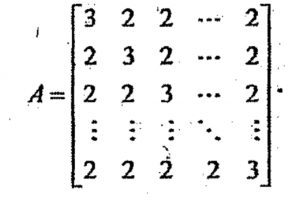George Saliaris
Junior Member
- Joined
- Dec 15, 2019
- Messages
- 53
I am practicing for my exams in Linear Algebra and I came across this determinant...
I noticed that A (the matrix which has the determinant above) = 2B + I
where B has '1's in every column and row.I also got that B^2 = nB ,so if λ is an eigenvalue of B then λ^2 is an eigenvalue of Β^2.So λ = 0 οr λ = n..
Also,if C = 2B then if d is an eigenvalue of C,then d+1 is an eigenvalue of C+I..We also have that the determinant of a matrix is equal to the product of its eigenvalues..So maybe I am supposed to find the eigenvalues of I in terms of the eigenvalues of C,I ? If so,I do not know the multiplicity of each eigenvalue...How can I continue?
I noticed that A (the matrix which has the determinant above) = 2B + I
where B has '1's in every column and row.I also got that B^2 = nB ,so if λ is an eigenvalue of B then λ^2 is an eigenvalue of Β^2.So λ = 0 οr λ = n..
Also,if C = 2B then if d is an eigenvalue of C,then d+1 is an eigenvalue of C+I..We also have that the determinant of a matrix is equal to the product of its eigenvalues..So maybe I am supposed to find the eigenvalues of I in terms of the eigenvalues of C,I ? If so,I do not know the multiplicity of each eigenvalue...How can I continue?

